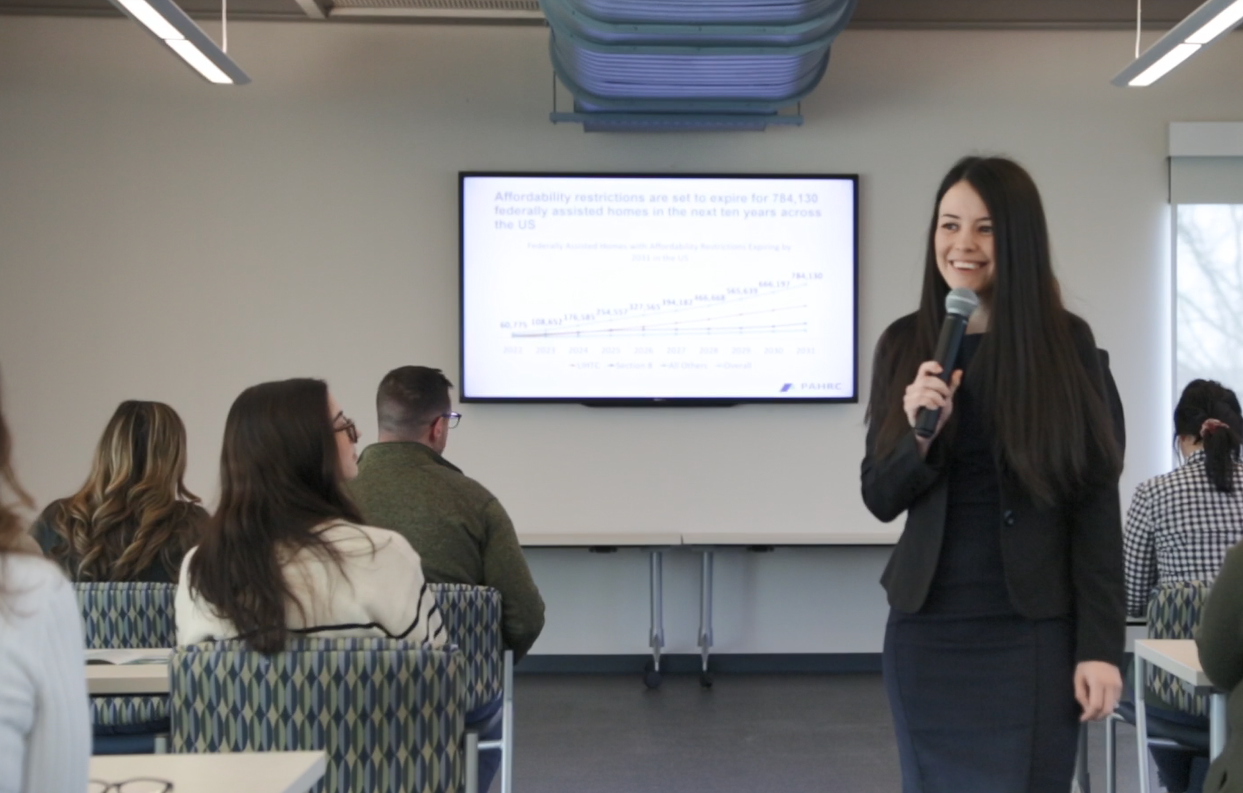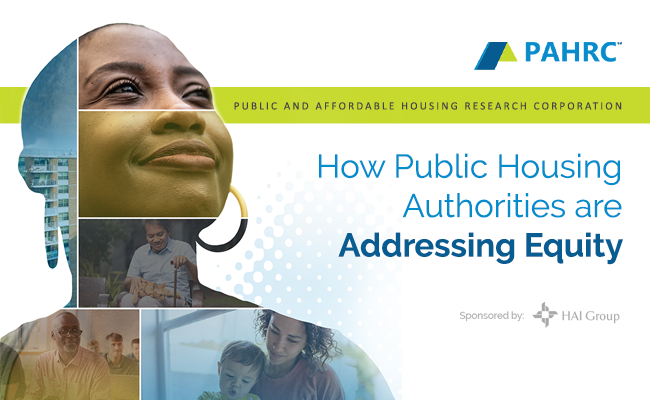At a time when a safe and affordable place to call home is out of reach for more than 15 million Americans, the preservation and development of affordable homes is more important than ever. For over a decade, HAI Group’s research division, the Public and Affordable Housing Research Corporation (PAHRC), has been on a mission to provide data, research, and tools to support affordable housing. These resources help policymakers, housing providers, and advocates spotlight the impact, outcomes, and value that affordable homes bring to families and communities.
Michael Torelli sat down with Kelly McElwain, manager of research and industry intelligence at PAHRC, to discuss her work.
Michael Torelli: Thank you for taking the time to speak with me, Kelly. PAHRC has become a significant player in the affordable housing research industry in recent years, but for somebody who has never heard of this organization, how would you describe what PAHRC does?
Kelly McElwain: PAHRC, which is pronounced ‘park,’ is a nonprofit that compiles research and data tools to build an evidence-based case for why affordable housing matters. We do this by collaborating with industry partners, collecting data, and conducting research. PAHRC also delivers data and tools, such as the National Housing Preservation Database (NHPD), that help local governments and stakeholders locate affordable homes in their community, which can inform local affordable housing needs assessments and preservation strategies.
MT: Can you talk about what topics PAHRC’s research has explored?
KM: Over the years, PAHRC’s research has:
- Dispelled myths about who lives in affordable homes in our Housing Impact Report.
- Provided a roadmap for affordable housing providers to replicate innovative programs that enable their residents to thrive in PHA Pathways for Advancing Equity, Strategize, Start, and Sustain, and How Housing is Advancing Educational Outcomes.
- Highlighted challenges affordable housing providers face preserving their affordable housing stock in our Picture of Preservation Report and Balancing Priorities reports.
- Described the characteristics of neighborhoods where affordable homes are located in Natural Hazards and Federally Assisted Housing and Strategies for Investing in Opportunity reports to help property owners assess neighborhood conditions, inform grant proposals, and prioritize properties to acquisition and redevelopment.
MT: Can you talk about the impact that PAHRC has had on the industry over the years?
KM: Property level data on the affordable housing stock made available through the National Housing Preservation Database (NHPD) have been used by thousands of people to:
- Advocate for millions of dollars in funding to build and protect affordable housing.
- Equip cities and lending institutions with the information they need to develop affordable housing preservation plans.
- Enact policies that support the preservation of affordable homes.
- Expand public transportation near affordable homes.
- Locate affordable homes to move into or acquire and preserve.
Many studies sponsored and advised by PAHRC’s research team have made the case to Congress to expand funding and flexibilities for Public Housing Authorities (PHAs), including:
- Assessing the Economic Benefits of Public Housing, which found that $2.12 is returned to the local community’s economy for every $1 spent by PHAs, and was referenced by Congress to support the $4 billion in American Recovery and Reinvestment Act funds that PHAs received in 2009.
- Innovations in the Moving to Work Demonstration, which highlighted the policies and programs PHAs implemented using their regulatory flexibility, and was cited by Congress to support the expansion of this program in 2016.
PAHRC’s research has also been widely cited in the media to raise awareness about the challenges affordable housing providers face, the populations they serve, and the importance of the services they provide to their community.
MT: What does an average day look like for you at PAHRC?
KM: Our research team often works on multiple projects simultaneously, which means our day-to-day can vary greatly. Our daily tasks include updating data for the NHPD and supporting its users, analyzing data on affordable housing programs, writing reports, collaborating with partners on projects, and preparing presentations for webinars and conferences. Juggling so many different projects helps us keep our finger on the pulse of what’s going on within our industry.

PAHRC’s research team, Kelly McElwain and Cate Asp, presenting at CLPHA’s 2025 Spring Meeting.
MT: Can you share some examples of how affordable housing organizations can use PAHRC’s research and data tools?
KM: Our Strategize Start and Sustain and PHA Pathways for Advancing Equity reports provide a roadmap for PHAs to implement initiatives to improve health, education, and employment outcomes for residents. PAHRC’s Neighborhood Opportunity Search Tool is another resource that provides data housing organizations can use to assess access to health, education, employment, and transit in a community, and describes investment pathways to pursue to help residents achieve economic independence. And our Preservation Toolkit summarizes key characteristics of the affordable housing stock in cities across the country and presents strategies local governments can pursue to preserve these properties. More insight on how affordable housing providers can use PAHRC’s research can be found here.
MT: Those are some sizable initiatives you’ve developed. Can you expand on how you establish your research agenda?
KM: PAHRC works closely with our board and partners, such as the Council of Large Public Housing Authorities, the Public Housing Authorities Directors Association, the National Association of Housing and Redevelopment Officers, the MTW Collaborative, the National Low Income Housing Coalition, and many more, to establish our research agenda. We collaborate with our partners to identify knowledge gaps, misconceptions, and pressing challenges affordable housing providers face.
Our team aims to provide actionable solutions and resources affordable housing providers and local governments can use to more effectively preserve their affordable housing stock and implement policies and programs that provide low-income families with the stability they need to grow and thrive.
MT: I know you’ve achieved a lot in the past decade, but as you look to the future, where would you like to take PAHRC over the next ten years?
KM: Over the next ten years, my goal for PAHRC is to continue pursuing research, building data tools, and delivering presentations that give housing providers resources to implement strategies that help their residents thrive. However, much of this work is impossible without adequate financial and regulatory support from Congress. For that reason, I also aspire to continue producing research that makes a case for the impact that affordable housing provides to equip stakeholders to advocate for the funding and policies needed to expand and protect access to affordable housing. One way our team will be doing this is by helping achieve the research objectives for the 10-Year Roadmap for Public Housing Sustainability.
MT: Thank you for sharing this information with us, Kelly.
If you’re interested in learning more about PAHRC, visit www.pahrc.org to check PAHRC’s latest research reports and data tools.
This article is for general information only. HAI Group® makes no representation or warranty about the accuracy or applicability of this information for any particular use or circumstance. Your use of this information is at your own discretion and risk. HAI Group® and any author or contributor identified herein assume no responsibility for your use of this information. You should consult with your attorney or subject matter advisor before adopting any risk management strategy or policy.
HAI Group® is a marketing name used to refer to insurers, a producer, and related service providers affiliated through a common mission, management, and governance. Property-casualty insurance and related services are written or provided by Housing Authority Property Insurance, A Mutual Company; Housing Enterprise Insurance Company, Inc.; Housing Specialty Insurance Company, Inc.; Housing Investment Group, Inc.; and Housing Insurance Services (DBA Housing Insurance Agency Services in NY and MI).





